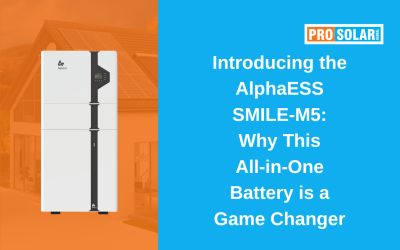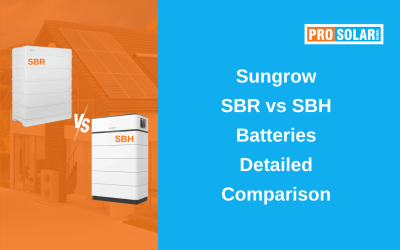If you’re choosing a solar battery in 2025, you’ll likely come across two main types: stackable and non‑stackable battery systems.
Each type has pros and cons when it comes to space, cost, safety, scalability and installation. At Prosolar Global, we break down the differences so you can confidently choose the right design for your energy needs.
What Are Stackable vs Non‑Stackable Batteries? Stackable Batteries
These are modular systems where battery units are physically stacked on top of one another, like building blocks. They usually don’t require external cabling between modules.
Example brands:
- Sungrow SBR/SBH
- BYD Battery-Box Premium HVS/HVM
- Alpha ESS SMILE G3 series
Non-Stackable Batteries
In these systems, battery modules are mounted side-by-side or in a rack. They require separate wiring between units and often come with more installation flexibility.
Example brands:
- Tesla Powerwall 2
Enphase IQ Battery (AC-coupled)
Key Differences: Stackable vs Non-Stackable
| Feature | Stackable Batteries | Non‑Stackable Batteries |
| Installation | Quick, plug‑and‑play stacking | Wall‑mount or separate rack install |
| Space Usage | More compact, smaller footprint | Takes up more horizontal space |
| Cabling | No cables between modules | Needs interconnect wiring |
| Scalability | Easy vertical expansion | Often limited to fixed sizes or boxed units |
| Cooling & Ventilation |
Natural vertical airflow | May require more spacing for airflow |
| Aesthetic Appeal | Sleek and modern tower style | Depends on model, but often bulkier |
| Weight Distribution | Vertical stacking may need level surface | Better weight spread across wall/floor |
| Best For | New homes, garages, internal installs | Retrofitting, small spaces, wall-only areas |
1. Installation Time & Labour
Stackable systems are usually faster to install. Since they’re pre-designed to fit together without internal cabling, they:
- Reduce electrician labour time
- Lower install errors
- Require fewer brackets and fasteners
Non-stackable systems may take longer, especially if wall-mounting or needing external wiring and brackets.
Tip: If you want a fast, clean install with less room for error, stackable is ideal.
2. Space & Appearance
Stackable batteries have a smaller floor footprint and look like a sleek cabinet or tower. They’re perfect for:
- Inside garages
- Utility rooms
- Protected outdoor areas
Non-stackable systems often need:
- Wall space
- Extra clearance
- Anchor points for weight and heat dissipation
Tip: If you’re tight on wall space but have floor space, stackable is the better design.
3. Scalability & Future Expansion
Many stackable systems (like BYD HVS or Sungrow SBH) let you start with 2–3 modules and add more later—up to 20–40 kWh or more.
Some non-stackable systems are modular in electronics but not form—you may need to buy a full second unit to expand capacity (e.g. another Tesla Powerwall or Enphase IQ 10).
Tip: Choose stackable if you plan to expand your storage in stages.
4. Heat Management & Longevity
Stackable batteries naturally promote vertical heat dissipation, reducing stress on lower modules. However, very tight installations without airflow can overheat during summer.
Non-stackable batteries, when properly spaced and mounted, may offer better airflow, especially in wide, open garages or sheds.
Tip: Always check manufacturer cooling specs—and avoid stacking batteries in closed, hot cupboards.
5. Maintenance & Replacement
Stackable systems make module replacement easy. If one unit fails, it can often be unstacked and swapped without touching the rest.
In contrast, non-stackable units like Tesla Powerwall are sealed. If one fails, you must replace the entire unit, not just a module.
Tip: Stackable wins for long-term serviceability and modular replacement.
6. Structural Requirements
- Stackable batteries may weigh 100–300 kg+ fully stacked, needing solid floors or platforms. Outdoor installs must be level and flood-protected.
- Non-stackable batteries (especially wall-mounted) must be fixed to load-bearing walls and may require brackets or wall reinforcements.
Tip: Choose stackable if your walls can’t support heavy batteries, or you’re installing in sheds or slab floors.
When to Choose a Stackable Battery
✔ You have space on the ground (garage, storage room)
✔ You want a battery that grows with your needs
✔ You prefer plug‑and‑play setup with less wiring
✔ You care about ease of maintenance
✔ Your installer recommends a newer hybrid inverter
When to Choose a Non-Stackable Battery
✔ You need to wall-mount the battery
✔ You want an all-in-one sealed unit like Powerwall 2
✔ You’re using a brand-specific ecosystem (e.g. Tesla, Enphase)
✔ You want battery+inverter in a single compact enclosure
✔ You prefer horizontal layout due to low ceilings or shed size
Summary Table
| Factor |
Best for Stackable |
Best for Non-Stackable |
| Quick installation | ✅ | ❌ |
| Tight wall space | ✅ | ❌ |
| Wall-mount option | ❌ | ✅ |
| Expandability | ✅ | ❌ (often fixed size) |
| Stylish tower look | ✅ | ⚠️ (model dependent) |
| Modular maintenance | ✅ | ❌ (sealed units) |
Conclusion
Both stackable and non‑stackable solar battery types have their place in the Australian market. The best choice comes down to your space, scalability needs, budget, and design preferences.
Stackable batteries are increasingly popular in 2025 for their modularity, sleek design, and fast installs. But if you’re after a wall-mounted option or a one-box solution, non‑stackable might suit better.
Need help choosing the right battery design for your home or business?
Talk to our expert by calling them on 1300 181 191 to get tailored advice on the best stackable or non‑stackable battery options for your solar system.




